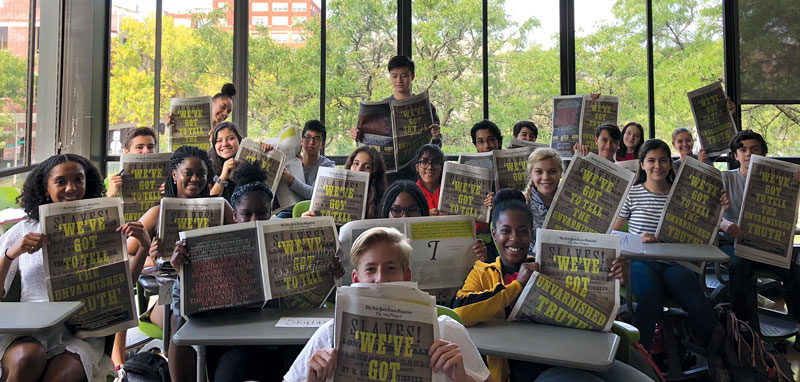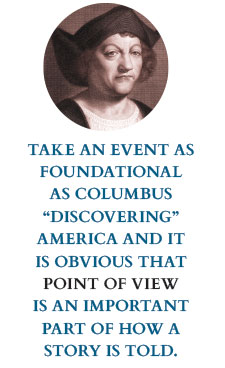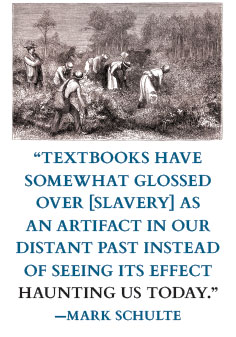Truth in Textbooks: Unpacking Bias in Curriculum Staples
Students have traditionally accepted information in textbooks without question. But In high schools throughout the country, that's starting to change.
 |
Students at Whitney M. Young Magnet High School in Chicago with printed sections of the New York Times 1619 Project.Photo courtesyof Whitney M. Young High School/Anne-Michele Boyle |
Stephanie Gamble was perplexed. As the academic liaison librarian at Johns Hopkins University, she knew her students were sophisticated at finding information on a topic and that they possessed the basic skills to vet information for bias and veracity. But when these same students encountered material in a textbook, it was as though their critical thinking skills shut down: They accepted the information without question.
She explained to them that although textbooks include information and facts, the material was still written by people, so it can be subject to the same biases that might affect, say, a newspaper story or a tweet. “It was hard for incoming students [to understand],” she says. “They aren’t taught to do that.”
In high schools throughout the country, that unquestioning acceptance is starting to change. As fabricated stories and accusations of fake news, valid or not, have proliferated in the last five years, teachers and librarians are finding ways to get students to extend their verification skills to textbooks and learn to question all the information they consume—whether it’s from social media or a seven-pound textbook that has been written, edited, and state-adopted.
“Students should be expected to believe what’s in textbooks,” says Mark Schulte, the education director at the Pulitzer Center, a nonprofit that supports journalism and works with schools and universities to bring issues and reporters into classrooms. “They are meant to be authoritative, but textbook authors are subject to the same biases that all of us have. That’s a problem.”
 Imagine a high school student encountering a textbook written as the authoritative word, says Bob Bain, an associate professor at the University of Michigan’s School of Education. “There’s no hedging language [or alternative theories]. Students treat its information like the answers in the back of an algebra book.”
Imagine a high school student encountering a textbook written as the authoritative word, says Bob Bain, an associate professor at the University of Michigan’s School of Education. “There’s no hedging language [or alternative theories]. Students treat its information like the answers in the back of an algebra book.”
It’s no secret that there are obvious problems with the $5 billion-a-year K–12 curriculum market. The textbook adoption process can be dictated by a few large states; books can take years to complete and are typically in schools for a decade or longer, and the quirky nature of approval means that sometimes outright falsehoods are presented as facts.
While California, Florida, and Texas still complete statewide textbook reviews that can sway the entire market, fewer than half of all states now conduct independent reviews, diminishing the industry’s oversight. Districts, even inside the largest states, have more freedom than ever to purchase materials not on the state-approved lists. However, the onerous task of trying to vet so many books means that many of the schools will end up using the state list.
Finding troubling errors in various textbooks became a sort of “whack-a-mole” exercise in recent years. History textbooks are frequently cited for issues such as calling enslaved people “workers” and downplaying slavery as the key issue in the Civil War. The problems are so widespread that James W. Loewen, professor emeritus of sociology at the University of Vermont, issued a second edition of his book Lies My Teacher Told Me: Everything Your American History Textbook Got Wrong. It published last year.
It isn’t just history textbooks that are problematic, as a physicist at North Carolina State University found when he scoured 12 science textbooks. John L. Hubisz discovered mistakes that included inaccurately describing Newton’s first law of motion and basic scientific theory.
The bias problem
As serious as those factual errors are, the bias found in many textbooks can dismay teachers or librarians and deceive students. Take an event as foundational as Columbus “discovering” America and it is obvious that point of view is an important part of how a story is told.
When Bain was a high school history teacher, he devised a lesson plan to help his students understand all the subtleties that go into creating a wide-ranging history textbook. He decided to make his students authorities on one topic: the bubonic plague that spread through Asia, Europe, and Africa in the 14th century.
Bain gave students 50 documents on the subject to consider, allowed them to articulate a question they wanted to investigate, and had them work in teams to create written reports of up to 10 pages. Not a single student referred to the class textbook. Their papers used footnotes and made arguments. The groups shared their work with classmates, some of whom suggested consulting different documents. Then the students incorporated their peers’ feedback into the final product.
At the end of the week, Bain assigned the students to read the textbook’s version of the plague. “They came in Monday flummoxed,” he says. They were livid that the textbook had given the period just one page. “That’s all they wrote?” his students asked. “One-third of the European population died.” They pointed out the lack of footnotes and any mention of alternative interpretations of the event.
“I had made their knowledge base and experience stronger than what the textbook had to offer,” Bain says. He pressed students to justify why they were more knowledgeable on the topic and they recounted how they read primary documents, how they examined church records of that period, and used secondary sources to put the information into perspective.
Then Bain turned the tables, asking students how many of the documents that they were given had originated in China, where the plague started. (None.) He told them these documents existed, but because they hadn’t been translated, he couldn’t read them. “They said, ‘The history we’re getting is through your interpretation?’ I said, ‘Yeah, of course. The same thing is true of any archive you go to. All of history is a bit tentative with all sorts of inferences.’”
Bain’s lesson took less than two weeks’ class time, and he remembers that it was always worthwhile. “The time I invest early in the course helps later. It’s like a good sports coach doing drills.”

Reframing American slavery
How textbooks handle slavery has been a particular point of grievance among educators. “Textbooks have somewhat glossed over [slavery] as an artifact in our distant past instead of seeing its effect haunting us today,” Schulte says.
Teachers can offend or mislead students with clumsy phrases or culturally outdated concepts they cite from textbooks. In addition, textbooks frequently give the topic short shrift in the timeline of American history.
The recent 1619 Project from the New York Times reframes not only what happened during slavery, but also how its impact continues to be felt today. Originally a series of essays, poems, and stories for the newspaper’s magazine section this summer, the 1619 Project is starting to be used by schools nationwide as a way to investigate the legacy of slavery in various parts of the United States. (See “'1619 Project' Poised To Reframe Teaching of Slavery.”)
The Pulitzer Center created a related curriculum and is running professional events around the country with Times’s authors, including the project’s leader, Nikole Hannah-Jones.
The section was published in August to coincide with the 400th anniversary of the arrival of the first enslaved Africans in English North America. It has already drawn “an astounding response” from educators, Schulte says.
His team and Hannah-Jones kicked off the school year at Bard High School Early College Queens in New York City, where students spent five days reading the magazine, discussing its contents, and creating their own written work on the topic.
 In an annual program, Bard students not only conduct critical reading and writing, but they also learn how to participate in an intimate intellectual community by listening to different ideas, presenting personal work for feedback, and providing thoughtful criticism of others’ work. Hannah-Jones was so impressed with the work presented that she spontaneously invited a senior to participate with her in the October 30 program for the project at the National Museum of African American History and Culture.
In an annual program, Bard students not only conduct critical reading and writing, but they also learn how to participate in an intimate intellectual community by listening to different ideas, presenting personal work for feedback, and providing thoughtful criticism of others’ work. Hannah-Jones was so impressed with the work presented that she spontaneously invited a senior to participate with her in the October 30 program for the project at the National Museum of African American History and Culture.
While Schulte says that the project is not the “single, definitive account” of slavery, it does become an invitation to re-examine a lot of issues, providing “a critical approach to thinking about history” that includes a contemporary discussion.
Teachers and librarians are finding ways to balance the use of textbooks by mixing in additional resources, from databases, news articles, and other materials. “A variety of sources is the trend,” says Barry Hanrahan, head librarian at Wheeling (IL) High School.
Particularly for students in the school’s AP history classes, “We teach about bias in primary source documents,” Hanrahan says, along with how to evaluate an eyewitness to history, and how secondary sources need to be evaluated differently.
One favorite method is to have students judge which documents on a certain topic would make the best argument. Hanrahan points out that the changing landscape of history, such as the legalization of marijuana in many states, prove that “it’s important for schools to keep the needle moving. The skills we’re teaching aren’t topic-specific, they’re life-specific.”
The libraries in Hanrahan’s district, High School District 214, were collectively chosen as the American Library Association’s National School Library of the Year. But even before that distinction, the librarian said his district valued librarians’ contributions while collaborating with classroom teachers on curricula, ensuring that students get a more rounded view of history than a single textbook.
Bain recommends incorporating current online information with textbooks while always pressing students to think about how the lives of people in various eras were either similar to or different from theirs. “We make sense of our present by the story we tell ourselves. What I want kids to do is to understand where that story comes from.”
Wayne D’Orio writes frequently about education and equity.
All pullquote images from Getty Images
RELATED
The job outlook in 2030: Librarians will be in demand
The job outlook in 2030: Librarians will be in demand
ALREADY A SUBSCRIBER? LOG IN
We are currently offering this content for free. Sign up now to activate your personal profile, where you can save articles for future viewing





Add Comment :-
Comment Policy:
Comment should not be empty !!!